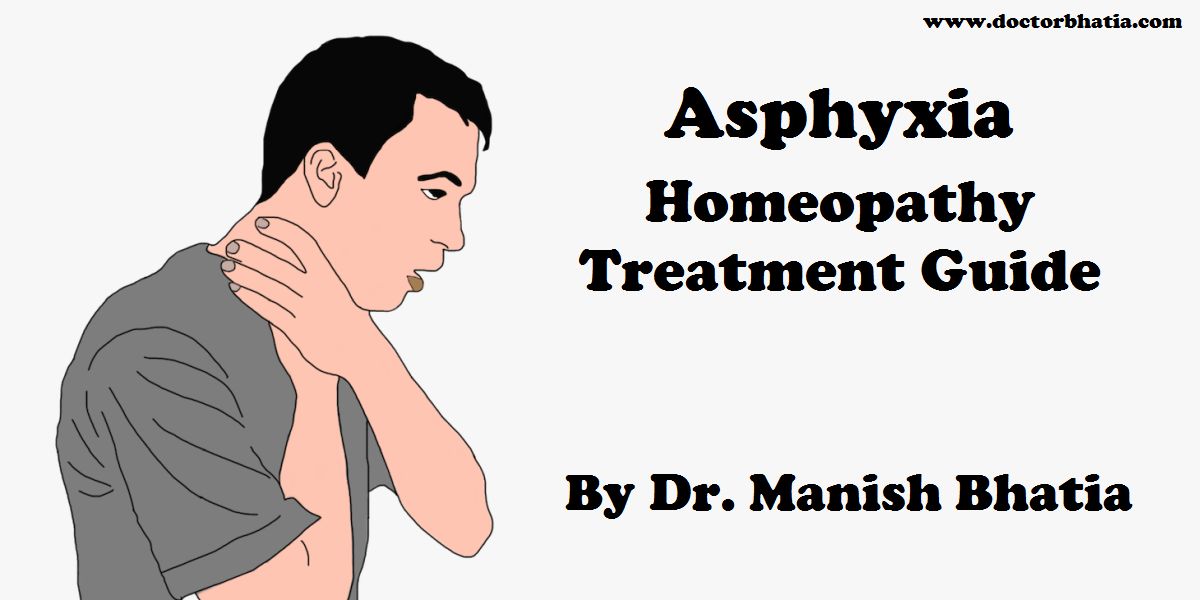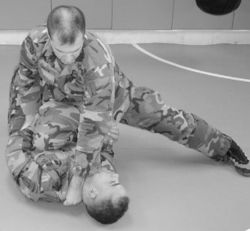Asphyxia (from Greek a-, “without” and (sphygmos), “pulse, heartbeat”) is a condition of severely deficient supply of oxygen to the body that arises from being unable to breathe normally. An example of asphyxia is choking. Asphyxia causes generalized hypoxia, which primarily affects the tissues and organs.
- Carbon monoxide inhalation, such as from a car exhaust: carbon monoxide has a higher affinity than oxygen to the hemoglobin in the blood’s red blood corpuscles, bonding with it tenaciously, and, in the process, displacing oxygen and preventing the blood from transporting it around the body
- Contact with certain chemicals, including pulmonary agents (such as phosgene) and blood agents (such as hydrogen cyanide)
- Self-induced hypocapnia by hyperventilation, as in shallow water or deep water blackout and the choking game
- A seizure which stops breathing activity
- Sleep apnea
- Drug overdose
- Ondine’s curse, central alveolar hypoventilation syndrome, or primary alveolar hypoventilation, a disorder of the autonomic nervous system in which a patient must consciously breathe; although it is often said that persons with this disease will die if they fall asleep, this is not usually the case
- Acute respiratory distress syndrome.
- Exposure to extreme low pressure or vacuum
- Breathing an industrial atmosphere lacking oxygen (e.g. welding gases, or in containers purged with nitrogen).
Smothering
Smothering refers to the mechanical obstruction of the flow of air from the environment into the mouth and/or nostrils, for instance, by covering the mouth and nose with a hand, pillow, or a plastic bag.[1] Smothering can be either partial or complete, where partial indicates that the person being smothered is able to inhale some air, although less than required. In a normal situation, smothering requires at least partial obstruction of both the nasal cavities and the mouth to lead to asphyxia. Smothering with the hands or chest is used in some combat sports to distract the opponent, and create openings for transitions, as the opponent is forced to react to the smothering. It is also used in BDSM as a type of facesitting.
In some cases, when performing certain routines, smothering is combined with simultaneous compressive asphyxia. One example is overlay, in which an adult accidentally rolls over an infant during co-sleeping, an accident that often goes unnoticed and is mistakenly thought to be sudden infant death syndrome.[1] Other accidents involving a similar mechanism are cave-ins or when an individual is buried in sand or grain. In homicidal cases, the term burking[2] is often ascribed to a killing method that involves simultaneous smothering and compression of the torso.[3]
Compressive asphyxia
The knee-on-belly position compresses the chest, making it difficult for the person on the bottom to breathe.
Compressive asphyxia (also called chest compression) refers to the mechanical limitation of the expansion of the lungs by compressing the torso, hence interfering with breathing. Compressive asphyxia occurs when the chest or abdomen is compressed posteriorly.[4] In accidents, the term traumatic asphyxia or crush asphyxia is usually used to describe compressive asphyxia resulting from being crushed or pinned under a large weight or force. An example of traumatic asphyxia includes cases in which an individual has been using a car-jack to repair a car from below, only to be crushed under the weight of the vehicle[3] when the car-jack slips. Pythons, anacondas, and other constrictor snakes kill through compressive asphyxia.
In fatal crowd disasters, contrary to popular belief, it is not the blunt trauma from trampling that causes the large part of the deaths, but rather the compressive asphyxia from being crushed against the crowd. In confined spaces, people push and lean against each other; evidence from bent steel railings in several fatal crowd accidents have shown horizontal forces over 4500 N (comparative weight approximately 460kg). In cases where people have stacked up on each other forming a human pile, estimations have been made of around 380kg of compressive weight in the lowest layer.[5]
The cause of death of detainees who have been restrained and left prone, for example in police vehicles, and are unable to move into safer positions has been referred to as ‘positional asphyxia’.
Chest compression is also featured in various grappling combat sports, where it is sometimes called wringing. Such techniques are used either to tire the opponent or as complementary or distractive moves in combination with pinning holds,[6] or sometimes even as submission holds. Examples of chest compression include the knee-on-stomach position, or techniques such as leg scissors (also referred to as body scissors and in budo referred to as do-jime,[7], “trunk strangle” or “body triangle”)[8] where you wrap the legs around the opponent’s midsection and squeeze them together.[9]
Pressing is a form of torture or execution that works through asphyxia.
Perinatal asphyxia
Perinatal asphyxia is the medical condition resulting from deprivation of oxygen (hypoxia) to a newborn infant long enough to cause apparent harm. It results most commonly from a drop in maternal blood pressure or interference during delivery with blood flow to the infant’s brain. This can occur due to inadequate circulation or perfusion, impaired respiratory effort, or inadequate ventilation. Perinatal asphyxia happens in 2 to 10 per 1000 newborns that are born a terme.
Homeopathy Treatment for Asphyxia
Keywords: homeopathy, homeopathic, treatment, cure, remedy, remedies, medicine
Homeopathy treats the person as a whole. It means that homeopathic treatment focuses on the patient as a person, as well as his pathological condition. The homeopathic medicines are selected after a full individualizing examination and case-analysis, which includes the medical history of the patient, physical and mental constitution, family history, presenting symptoms, underlying pathology, possible causative factors etc. A miasmatic tendency (predisposition/susceptibility) is also often taken into account for the treatment of chronic conditions. A homeopathy doctor tries to treat more than just the presenting symptoms. The focus is usually on what caused the disease condition? Why ‘this patient’ is sick ‘this way’. The disease diagnosis is important but in homeopathy, the cause of disease is not just probed to the level of bacteria and viruses. Other factors like mental, emotional and physical stress that could predispose a person to illness are also looked for. No a days, even modern medicine also considers a large number of diseases as psychosomatic. The correct homeopathy remedy tries to correct this disease predisposition. The focus is not on curing the disease but to cure the person who is sick, to restore the health. If a disease pathology is not very advanced, homeopathy remedies do give a hope for cure but even in incurable cases, the quality of life can be greatly improved with homeopathic medicines.
The homeopathic remedies (medicines) given below indicate the therapeutic affinity but this is not a complete and definite guide to the homeopathy treatment of this condition. The symptoms listed against each homeopathic remedy may not be directly related to this disease because in homeopathy general symptoms and constitutional indications are also taken into account for selecting a remedy. To study any of the following remedies in more detail, please visit the Materia Medica section at Hpathy.
None of these medicines should be taken without professional advice and guidance.
Homeopathy Remedies for Asphyxia :
Acet-ac., acon., ant-t., arn., ars., bell., camph., carb-s., carb-v., chin., chlor., coch., coff., coloc., crot-h., hydr-ac., laur., merc., nit-ac., op., ph-ac., phos., rhus-t., sin-n., stram., sul-ac., tab.
References
- ^ a b Ferris, J.A.J. Asphyxia. www.pathology.ubc.ca. URL’s last accessed March 1, 2006 (DOC format)
- ^ The term “burking” comes from the method William Burke and William Hare used to kill their victims during the West Port murders. They killed the usually-intoxicated victims by sitting on their chests and suffocating them by putting a hand over their nose and mouth, while using the other hand to push the victim’s jaw up. The corpses had no visible injuries, and were supplied to medical schools for money.
- ^ a b DiMaio, Vincent; DiMaio, Dominick (2001). Forensic Pathology, Second Edition. Selected Pages from CHAPTER 8 and from Deaths Occurring Following the Application of Choke or Carotid Holds. www.charlydmiller.com. URL last accessed March 2, 2006.
- ^ Jones, Richard. Strangulation. www.forensicmed.co.uk. URL last accessed February 26, 2006.
- ^ Fruin, John. The Causes and Prevention of Crowd Disasters. www.crowddynamics.com. URL last accessed March 3, 2006.
- ^ Ohlenkamp, Neil Principles of Judo Choking Techniques. judoinfo.com. URL last accessed on March 3, 2006
- ^ Do-jime is a prohibited technique in Judo, (The Kodokan Judo Institute. Kodokan.Org classification of techniques. www.kodokan.org. URL last accessed March 4, 2006.) and is considered a ‘slight infringement’ according to IJF rules, Section 27: Prohibited acts and penalties, article 21. It should not be confused with do-osae, which is a colloquial term for the guard position.
- ^ International Judo Federation. IJF Referee Rules. www.ijf.org. URL last accessed March 6, 2006
- ^ Lewis, Bill. Katsuhiko Kashiwazaki – Shimewaza (Book Review). www.bjj.org. URL last accessed March 4, 2006.



